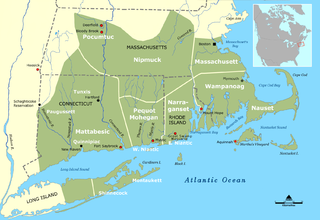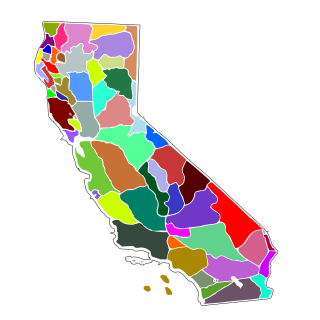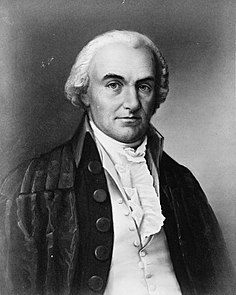
The Nonintercourse Act is the collective name given to six statutes passed by the Congress in 1790, 1793, 1796, 1799, 1802, and 1834 to set Amerindian boundaries of reservations. The various Acts also regulate commerce between Americans and Native Americans. The most notable provisions of the Act regulate the inalienability of aboriginal title in the United States, a continuing source of litigation for almost 200 years. The prohibition on purchases of Indian lands without the approval of the federal government has its origins in the Royal Proclamation of 1763 and the Confederation Congress Proclamation of 1783.

The Eightieth United States Congress was a meeting of the legislative branch of the United States federal government, composed of the United States Senate and the United States House of Representatives. It met in Washington, DC from January 3, 1947, to January 3, 1949, during the third and fourth years of Harry Truman's presidency. The apportionment of seats in this House of Representatives was based on the Sixteenth Census of the United States in 1940. Republicans gained a majority in both chambers for this Congress having gained thirteen Senate seats and fifty-seven House seats. Although the 80th Congress passed a total of 906 public bills, President Truman nicknamed it the "Do Nothing Congress" and, during the 1948 election, campaigned as much against it as against his formal opponent, Thomas Dewey. The 80th Congress passed several significant pro-business bills, most famously the Marshall Plan and the Taft–Hartley Act, but it opposed most of Truman's Fair Deal bills. Truman's campaign strategy worked, and the Republicans lost nine Senate seats and seventy-three seats in the House, allowing the Democrats to begin the 81st Congress with twenty-one more seats than they had at the end of the 79th Congress. It also allowed Truman to win a term of his own right as President, having become President after the death of Franklin D. Roosevelt in 1945.

The Sixty-fifth United States Congress was a meeting of the legislative branch of the United States federal government, composed of the United States Senate and the United States House of Representatives. It met in Washington, DC from March 4, 1917, to March 4, 1919, during the fifth and sixth years of Woodrow Wilson's presidency. The apportionment of seats in this House of Representatives was based on the Thirteenth Census of the United States in 1910. The Senate had a Democratic majority, and the House had a Republican plurality but the Democrats remained in control with the support of the Progressives and Socialist Representative Meyer London.
The Federal Rules of Criminal Procedure are the procedural rules that govern how federal criminal prosecutions are conducted in United States district courts and the general trial courts of the U.S. government. They are the companion to the Federal Rules of Civil Procedure. The admissibility and use of evidence in criminal proceedings is governed by the separate Federal Rules of Evidence.
BP America Production Co. v. Burton, 549 U.S. 84 (2006), was a United States Supreme Court case about whether a statute of limitations on government actions for contract claims applies to actions by a federal administrative agency to recover royalties on federal oil and gas leases. After two members recused themselves, the court ruled unanimously that it does not apply, in an opinion by Justice Samuel Alito.
In Pacific Gas & Electric Co. v. State Energy Resources Conservation & Development Commission, 461 U.S. 190 (1983), the United States Supreme Court held that a state statute regulating economic aspects of nuclear generating plants was not preempted by the federal Atomic Energy Act of 1954. The case provides a framework that has guided other cases involving preemption of federal authority.
United States v. Lara, 541 U.S. 193 (2004), was a United States Supreme Court case which held that both the United States and a Native American (Indian) tribe could prosecute an Indian for the same acts that constituted crimes in both jurisdictions. The Court held that the United States and the tribe were separate sovereigns; therefore, separate tribal and federal prosecutions did not violate the Double Jeopardy Clause.
Menominee Tribe v. United States, 391 U.S. 404 (1968), is a case in which the Supreme Court ruled that the Menominee Indian Tribe kept their historical hunting and fishing rights even after the federal government ceased to recognize the tribe. It was a landmark decision in Native American case law.
United States v. White Mountain Apache Tribe, 537 U.S. 465 (2003), was a case in which the Supreme Court of the United States held in a 5–4 decision that when the federal government used land or property held in trust for an Indian tribe, it had the duty to maintain that land or property and was liable for any damages for a breach of that duty. In the 1870s, the White Mountain Apache Tribe was placed on a reservation in Arizona. The case involved Fort Apache, a collection of buildings on the reservation which were transferred to the tribe by the United States Congress in 1960.

The United States was the first jurisdiction to acknowledge the common law doctrine of aboriginal title. Native American tribes and nations establish aboriginal title by actual, continuous, and exclusive use and occupancy for a "long time." Individuals may also establish aboriginal title, if their ancestors held title as individuals. Unlike other jurisdictions, the content of aboriginal title is not limited to historical or traditional land uses. Aboriginal title may not be alienated, except to the federal government or with the approval of Congress. Aboriginal title is distinct from the lands Native Americans own in fee simple and occupy under federal trust.
Oneida Indian Nation of New York v. County of Oneida, 414 U.S. 661 (1974), is a landmark decision by the United States Supreme Court concerning aboriginal title in the United States. The original suit in this matter was the first modern-day Native American land claim litigated in the federal court system rather than before the Indian Claims Commission. It was also the first to go to final judgement.
County of Oneida v. Oneida Indian Nation of New York State, 470 U.S. 226 (1985), was a landmark United States Supreme Court case concerning aboriginal title in the United States. The case, sometimes referred to as Oneida II, was "the first Indian land claim case won on the basis of the Nonintercourse Act."
Seneca Nation of Indians v. Christy, 162 U.S. 283 (1896), was the first litigation of aboriginal title in the United States by a tribal plaintiff in the Supreme Court of the United States since Cherokee Nation v. Georgia (1831). It was the first such litigation by an indigenous plaintiff since Fellows v. Blacksmith (1857) and its companion case of New York ex rel. Cutler v. Dibble (1858). The New York courts held that the 1788 Phelps and Gorham Purchase did not violate the Nonintercourse Act, one of the provisions of which prohibits purchases of Indian lands without the approval of the federal government, and that the Seneca Nation of New York was barred by the state statute of limitations from challenging the transfer of title. The U.S. Supreme Court declined to review the merits of lower court ruling because of the adequate and independent state grounds doctrine.

Joint a Tribal Council, of the Passamaquoddy Tribe v. Morton, 528 F.2d 370, was a landmark decision regarding aboriginal title in the United States. The United States Court of Appeals for the First Circuit held that the Nonintercourse Act applied to the Passamaquoddy and Penobscot, non-federally-recognized Indian tribes, and established a trust relationship between those tribes and the federal government that the state of Maine could not terminate.

Indian Land Claims Settlements are settlements of Native American land claims by the United States Congress, codified in 25 U.S.C. ch. 19.

The Narragansett land claim was one of the first litigations of aboriginal title in the United States in the wake of the U.S. Supreme Court's landmark Oneida Indian Nation of New York v. County of Oneida (1974), or Oneida I, decision. The Narragansett claimed a few thousand acres of land in and around Charlestown, Rhode Island, challenging a variety of early 19th century land transfers as violations of the Nonintercourse Act, suing both the state and private land owners.
South Carolina v. Catawba Indian Tribe, Inc., 476 U.S. 498 (1986), is an important U.S. Supreme Court precedent for aboriginal title in the United States decided in the wake of County of Oneida v. Oneida Indian Nation of New York State (1985). Distinguishing Oneida II, the Court held that federal policy did not preclude the application of a state statute of limitations to the land claim of a tribe that had been terminated, such as the Catawba tribe.

Aboriginal title in California refers to the aboriginal title land rights of the indigenous peoples of California. The state is unique in that no Native American tribe in California is the counterparty to a ratified federal treaty. Therefore, all the Indian reservations in the state were created by federal statute or executive order.
Aboriginal land title in New Mexico is unique among aboriginal title in the United States. Congressional legislation was passed to define such title after the United States acquired this territory following war with Mexico (1846-1848. But, the Supreme Court of the New Mexico Territory and the United States Supreme Court held that the Nonintercourse Act did not restrict the alienability of Pueblo lands.

The Crimes Act of 1790, formally titled An Act for the Punishment of Certain Crimes Against the United States, defined some of the first federal crimes in the United States and expanded on the criminal procedure provisions of the Judiciary Act of 1789. The Crimes Act was a "comprehensive statute defining an impressive variety of federal crimes."










